IDEX Online Research: U.S. Retail Jewelry Prices Fall In April
May 24, 12
(IDEX Online) – Retail jewelry prices in the American market fell by 1.5 percent in April, when compared to March prices. Further, retail jewelry prices rose by less than 1 percent in April, when compared to the same month a year ago. It has been almost two years – immediately following the end of the Great Recession – since we have seen inflation at this low level.
While retail jewelry prices were essentially stagnant in April, suppliers’ jewelry and watch prices continued to move up, though at a slower rate than in past months. Jewelry producer prices rose by 10 percent when compared to April 2011, but were up only 0.3 percent (three-tenths of one percent) when compared to March 2012.
The moderating inflation trends are primarily the result of stable to falling prices this year for polished diamonds and precious metals. None of the key jewelry commodities – polished diamonds, gold, silver or platinum – posted price increases in April, when compared to March.
While inflation may have moderated in the jewelry distribution channel, the gap between jewelry retail prices and jewelry supplier / producer prices remained worrisomely wide. Essentially, jewelry wholesale prices are continuing to rise faster than jewelry retail prices; this results in a margin squeeze among retail merchants.
Jewelry Wholesale Price Inflation Moderates in April
In April, the Jewelry Producer Price Index (JPPI) stood at 216.9, barely up from March’s 216.2; a year ago, the JPPI stood at 197.0. Here is what this data means:
· Wholesale jewelry prices were almost flat on a month-to-month comparison basis: April versus March 2012.
· Wholesale jewelry prices rose by about 10.1 percent on a year-to-year comparison basis: April 2012 versus April 2011. This is down notably from the inflation rates in the first quarter of 2012.
· Wholesale jewelry prices were up 12.5 percent for the four months year-to-date 2012 versus the same period a year ago.
· The JPPI was 100 in 1982, the “base” year. So, suppliers’ jewelry prices today are more than double the level they were in 1982. They are up by 2.7 percent annually, based on a compounded annual growth rate. Clearly, the current year-over-year inflation rate is dramatically above the thirty-year average, though there are signs that it is moderating.
· The graph below summarizes monthly JPPI over the past two years.
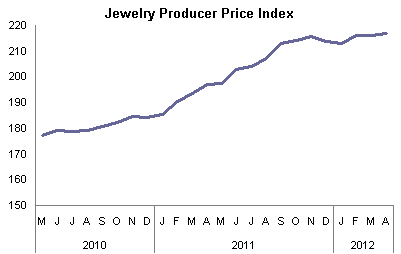 Source: BLS |
Jewelry Retail Price Inflation Evaporates in April
In April, the Jewelry Consumer Price Index (JCPI) stood at 167.1 versus March’s 169.6; a year ago, the JCPI stood at 165.6. Here is what this means:
· Retail prices of jewelry dropped by about 1.5 percent on a month-to-month comparison basis: April versus March 2012.
· Retail jewelry prices rose by a very modest 0.9 percent on a year-to-year comparison basis: April 2012 versus April 2011. In part, this is due to a steep rate of inflation during April 2011, so comparisons were very modest this year.
· The JCPI was 100 in 1986, the “base” year. Therefore, retailers’ jewelry prices today are up by roughly 67 percent in that twenty-five year period. They are up by 3.1 percent annually, based on a compounded annual growth rate. Clearly, the current year’s inflation rate is well below the twenty-five year average. It is also below the long-term JPPI growth rate, indicating that over the past two decades, retail jewelry prices have grown less rapidly than supplier prices.
· The graph below summarizes the JCPI over the past two years:
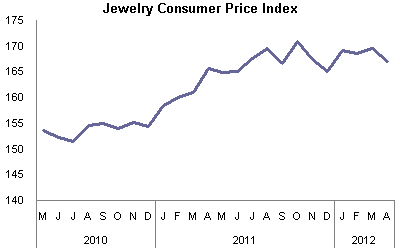 Source: BLS |
The Bottom Line: Increased Margin Squeeze for Retailers
Here is how this disparity in inflation rates between producers and retailers affects the American jewelry industry: the margin squeeze that specialty retail jewelers have felt since 2009 continues to manifest itself.
While commodity prices – gold, silver, platinum – seem more or less stable currently, they correlate somewhat to the global economic climate. If the global economy weakens – the OECD’s latest forecast suggests that economic growth will be mixed among the world’s largest economies in 2012 – then investors will likely start buying gold again, as a safe haven in an uncertain economy. This will push up gold prices, and jewelry suppliers will have no choice but to raise their prices. However, if the global economy weakens, consumer demand for jewelry will likely wane, and retail jewelers would be unable to pass along their higher cost jewelry. This will intensify the current margin squeeze that retailers are experiencing.
The table below provides detailed inflation rates for jewelry components as well as inflation rates at various levels of the jewelry distribution channel in the
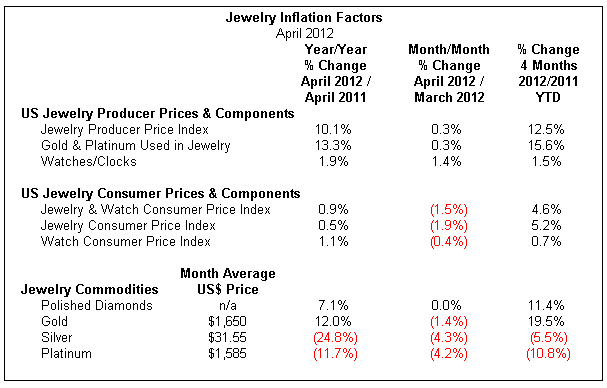 Source: Various markets |
Jewelry Suppliers’ Price Inflation Moderating
April’s jewelry supplier price inflation rate of 10.1 percent, year-to-year, was about in line with the jewelry supplier inflation rate of 9.3 percent for the full year 2010, and it was well above 2009’s supplier inflation rate of 3.3 percent. However, it reflected a flattening trend for month-to-moth wholesale / supplier jewelry price inflation.
After four months of 2012, jewelry supplier price inflation is up by 12.5 percent, an unusually high level.
The graph below summarizes year-over-year jewelry supplier price inflation on a monthly basis.
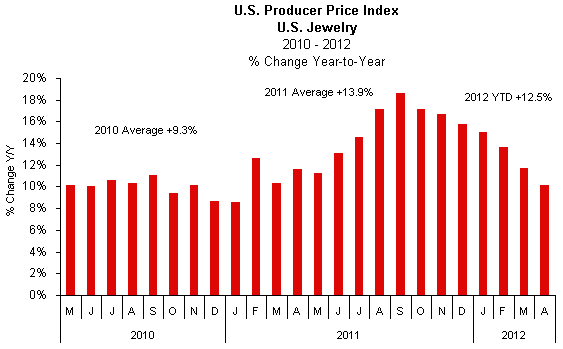 Source: BLS |
Higher Precious Metal Prices Continued to Drive Inflation Pace
Jewelry suppliers’ prices of precious metals jewelry rose by 13.3 percent during April 2012 versus the same month a year ago. This was notably above jewelry suppliers’ overall inflation rate for all jewelry and watches of 10.1 percent for the month.
On a month-over-month basis, jewelry suppliers’ prices for precious metal jewelry rose by just 0.3 percent in April versus March 2012. On an annualized basis, this would suggest that suppliers’ jewelry prices could rise by 3-4 percent or so. Last month (March 2012), month-to-month prices were flat. These unrealistic monthly swings illustrate why IDEX Online Research does not put much emphasis on monthly price changes: they simply are not meaningful.
The graph below compares the jewelry supplier inflation rate for precious metals jewelry (gold columns) versus the overall jewelry supplier inflation rate for jewelry (red columns). These comparisons are year-to-year.
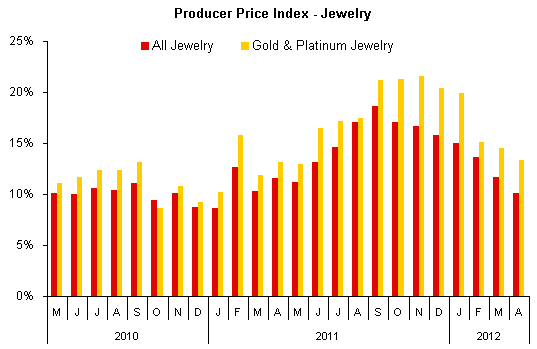 Source: BLS |
Watch Price Inflation Steady for Past Nine Months
Watch prices at the supplier level in April showed a moderate gain – +1.9 percent – when compared to the same month a year ago (April 2011). This level of inflation is reminiscent of inflation trends in 2009 and early 2010, when watch prices rose by a low single-digit level at the supplier level.
On a month-to-month basis – April 2012 versus March 2012 – supplier prices of watches were down only slightly. After four months of 2012, watch prices are up a modest 0.7 percent year-to-date.
In recent months, watch demand and watch sales in the
The graph below shows year-to-year supplier price inflation for watches for the past twenty-four months.
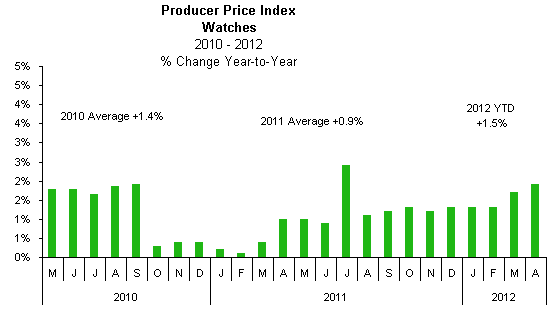 Source: BLS |
Jewelry and Watch Retail Price Evaporates in April
Jewelry and watch retail prices have been moderating since the third quarter of 2011. In April, retail jewelry price inflation evaporated: year-over-year prices were up just 0.9 percent at the retail level. We think this may be due to recent muted consumer demand for jewelry.
On a month-to-month basis, retail jewelry and watch prices in April were down 1.5 percent, when comparing April 2012 to March 2012. Comparing the first four months of 2012 versus the same four-month period last year, retail jewelry prices are up by just 4.6 percent.
The graph below summarizes year-to-year retail jewelry price inflation in the
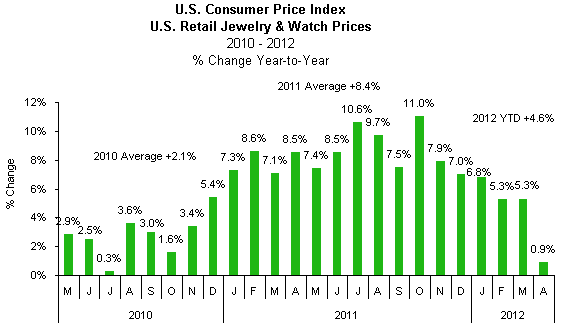 Source: BLS |
Retail Watch Prices Show Moderate Inflation in April
Retail and supplier prices of watches have tended to move together, with prices generally flattish, both on a month-to-month basis and a year-to-year basis, over the past few years.
For the month of April 2012, retail watch prices rose by 1.1 percent from April 2011. That is more or less in line with recent month comparisons of year-over year prices.
Retail prices of jewelry, excluding watches, were up 0.5 percent in April 2012, when compared to April 2011 prices. This is a dramatic decline from prior months.
The graph below compares the inflation rate for jewelry and watches (green bars), jewelry only (red bars), and watches (gold bars).
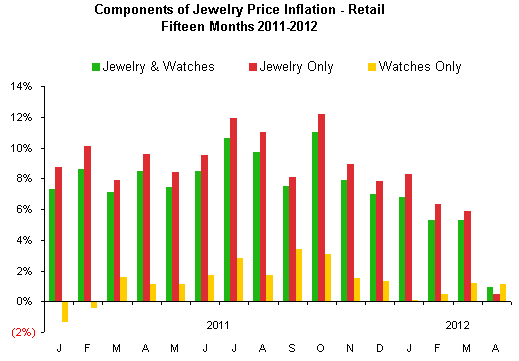 Source: BLS |
Jewelry Inflation Outlook: Moderating Inflation in 2012
Our outlook for jewelry price inflation remains unchanged: jewelry prices are expected to move higher at all levels of the distribution channel throughout 2012 and perhaps beyond. However, the rate of inflation is expected to be below 2011’s torrid pace, both at the supplier level and at the retail level.
It would be easy to forecast inflation for the jewelry industry if all of the commodities involved in the forecast were used exclusively by the jewelry industry. While that may be the case for polished diamonds, precious metals are used by a number of other industries. Further, gold is an international currency that plays in a financial arena of its own.
· Jewelry Industry Long Term Outlook – Demand from emerging economies such as
· Global Economic Outlook for 2012 – The latest OECD data points to moderate economic growth with a “positive” outlook for stronger growth in the next 12-18 months. However, there is some divergence among the growth of certain economies, especially given the current fiscal problems in
· Financial Markets Outlook for 2012 – With continued volatility in the world’s stock markets and uncertain valuations related to stocks, bonds and other hard assets, investors may seek the safe haven that gold offers. Despite predictions by others that gold will hit $2,000 this year, we are not ready to embrace those forecasts. This level would represent a mid-teen price increase. We see investor movement toward income-producing assets, and a move away from assets that do not produce income or an inflation hedge, such as gold.
The bottom line: inflation is headed higher over the longer term, but perhaps at a more moderate rate. Jewelry suppliers and retailers should use periods of weakness in commodity prices to add to their inventory.